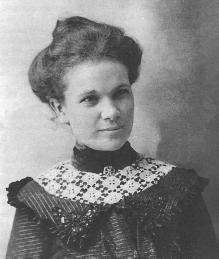The information below has been compiled from a variety of sources. If the reader has access to information that can be documented and that will correct or add to this woman’s biographical information, please contact the Nevada Women’s History Project.

At A Glance:
Born: March 1, 1880, Atascosa, Texas
Died: July 30, 1971, Reno, Nevada
Maiden Name: Mattie Collins Brite
Race: Caucasian
Nationality: “Texan”
Married:
Paul Friesen, 1896;
Alexander John Crewe, 1904;
John W. Kiley, 1908;
William A. Moss, 1915;
Frank Cropley, 1922 or 23;
Albert Kuhn, 1931;
William A. Moss, 1952
Children: son Carl Friesen; another child, possibly Alva Gedney Crewe
Primary residence: Texas, and Sparks and railroad towns in Nevada
Major Field of Work: telegraph operator
Pioneer female telegraph operator roamed the West
To read the story of Mattie “Ma Kiley” Kuhn is to think this was a woman who couldn’t hold a job or stay married. But while Mattie indeed married seven times and held dozens of jobs over her 91 years, she also opened doors that were previously closed to women in telegraphy.
During her career, Mattie worked as a telegraph operator, one of the few women to hold that job. Increasing traffic on single track railroad lines required more efficient operation and flexibility. Use of the telegraph enabled railroad dispatchers the ability to schedule trains and to move people and goods more quickly. She tapped out messages throughout the American West, and in Mexico and Canada, and ended up in Nevada where she retired in Sparks after years with the Southern Pacific Railroad.
She was born Mattie Collins Brite on March 1, 1880, in Atascosa, Texas, to Charles and Alva Brite. Her nomadic lifestyle began early. Her parents divorced when she was 3 years old. She and her sister Bennie (Bernice) went to live with Alva’s sister in Oak Island, near San Antonio, Texas.
Alva remarried to Daniel Franks, a ranch foreman. The two girls first lived with their father Charles, but he put them up with various other people until he remarried. Mattie’s brother Dan lived elsewhere.
After two years, all three children returned to their mother and stepfather in 1891, according to Mattie’s four-part autobiography titled “The Bug and I,” published by Railroad Magazine’s April-July 1950 monthly issues. “Bug” was a telegraph transmitter, she explained.
By then, she said she didn’t trust anyone, but living with her siblings and six step-siblings, “for the first time in my 11 years, I had a real home with affection and understanding.”
The family bought a fruit farm in Del Rio, Texas, but moved to Eagle Pass, Texas two years later where her mother ran a boarding house. In 1896, at a band concert, Mattie met Paul Friesen. She was 16, he was 36. They married a few months later, but Paul was abusive, and the marriage lasted only a few years, producing one son, Carl.
“There was nothing too good for him,” she wrote of Paul. “For me, there was nothing at all.”
Taking money from Paul’s pocket, Mattie bought railroad tickets back to her family for herself and her son. One of her mother’s boarders was a railroad telegrapher and he suggested Mattie learn telegraph operations. He rigged up a “set” for her to practice on.
About six months later, a Salt Lake City railroad telegraphy superintendent stopped by the boarding house and heard Mattie practicing. He was impressed enough to arrange for her to go to the local railroad depot and learn to receive telegraph messages; at home she could only practice sending them.
It took a long time to learn, she wrote, but her first completed “receive” was “The Queen is dead; long live the King.” The British Queen Victoria had died.
By 1902, Mattie was divorced from Paul Friesen and working as collector of customs in Eagle Pass, but still practicing telegraphy. She landed a railroad telegraphy job in Salinas, Mexico, then transferred to Durango, then Obayos.
In 1904, she married Alexander J. Crewe, a telegrapher from Nova Scotia, Canada, whom she met through the telegraph lines. That marriage lasted only 6 months, but Mattie became pregnant. She went to Del Rio until the baby was born, then returned to work in Obayos.
She never named the child in her autobiography, referring to the child only as “he,” “my baby” and “baby brother.” Another source lists a child born in 1905 as Alva Gedney Crewe, a girl.
Her next move, in 1905, was back to Del Rio for a job with Western Union. She transferred to El Paso. A 1906 job with an upstart telegraph-telephone company in Oro Grande, New Mexico, didn’t last. The company quickly went under, so it was off to Dallas and Western Union. Next came Western Union posts in Austin, Tyler and Amarillo, Texas.
When the wife of a telegraphers’ union president suggested she put her two children in a children’s home in Dallas as paid boarders because she moved around so much, Mattie took the advice. But while working in Amarillo, “I woke up dreaming that something was wrong with the baby.” She hurried to Dallas, but the baby died three days later.
When Western Union workers went on strike in 1907, Mattie hired on at the Rock Island Railroad and met John W. Kiley, her next husband. Kiley drank extensively, and they divorced; however, Mattie used “Ma Kiley” as her telegraph nickname for the rest of her career.
When Mattie got fired from Rock Island and blacklisted, apparently for refusing to send a Western Union telegram while that company’s workers were on strike, she left her son with friends in Oklahoma and went to Minneapolis.
She was 28 years old in 1908 and had fought an uphill fight with bosses and co-workers who didn’t think women should operate telegraphy equipment. Over the next couple of years, Mattie worked for the Milwaukee Road in Montana and North Dakota, and the Oregon Short Line in Idaho as a telegrapher, living in tiny rooms and dealing with men who didn’t want to rent rooms to her because she was a woman.
In about 1909, she was working for Western Union in the San Francisco Bay area when she was asked by her bosses to protest legislation for an 8-hour work day for women, she wrote in her magazine autobiography. Instead, she took a job at Western Pacific Railroad rather than protest legislation that would help women workers.
In her introduction to Nevada, Mattie was sent to Gerlach, a division point for Western Pacific Railroad. After only a few months, she took sick with appendicitis. After several operations and a long recovery, she headed to Canada.
After some moving around in Alberta for Canadian railroads, she moved back to Nevada in 1914 for a job on the Nevada Central Railroad in Austin. The Southern Pacific Railroad hired her in Sparks, Nevada. It was a busy office, “but I was very much at home,” she wrote. She brought her son Carl to Nevada to live with her.
In 1915, she married William Moss, in Lander County. By 1923, she was divorced from Moss, working in Sparks, and married to Frank Cropley. This marriage was also brief.
But in 1931, she was married to Albert Kuhn, who had boarded with her family in Texas 35 years earlier. They were happy and bought property in Reno to build a house, but Kuhn died of a heart attack in 1933.
Mattie’s story is of a woman who chose the nontraditional role of a working woman in the late 19th and early 20th centuries. An article in The Ogden Standard-Examiner on February 27, 1938, offers an insight on women telegraphers. Mattie C. Kiley is mentioned in this article.
“The clickety-clack of the railroad telegraph key seems to have a fascination which is drawing an ever-increasing number of women into the role of telegraphers.
Railroaders agree that working a trick at the key is a job women can do as well as men, and the pay, on an hourly basis, is the same for both.”
Mattie C. Kiley
Mattie retired from the Southern Pacific on a disability in 1943 after a railroad fireman threw a train order “hoop” at her and hit her head, she wrote.
Getting a retirement annuity was challenging because Mattie had worked for many different railroads, Western Union and the Postal. Only the railroad employment counted. With her many marriages and name changes she had a difficult time proving who she was and where she had worked. She took a reduced annuity because she was unable to establish that she had 30 years of working for railroads.
She apparently remarried her fourth husband William Moss in 1952, according the Ancestry.com and the U.S. Marriage Index of 1855-1955.
Also in 1952, Mattie, at age 73, was injured in a car accident on Glendale Road in Sparks. She sued for $10,000 in damages and received $5,000.
Mattie C. Kuhn, as she was named in her obituary in the Nevada State Journal, died on July 30, 1971, in Reno after a lengthy illness. She is buried in the Masonic Memorial Gardens beside Albert Kuhn. Her son Carl Friesen, died in Reno in 1987.
Researched by Patti Bernard and written by Susan Mullen. Posted March 2022.

Sources of Information
- Ancestry.com. Carson City, Nevada, U.S., Marriage Index, 1855-1985 [database on-line]. Provo, UT, USA: Ancestry.com Operations, Inc., 2015. [Mattie C. Kuhn]
- Ancestry.com. Year: 1880; Census Place: Atascosa, Texas; Roll: 1289; Page: 294B; Enumeration District: 00.3 [Mattie Brite]
- Ancestry.com. Year: 1900; Census Place: Justice Precinct 1, Val Verde, Texas; Page: 3; Enumeration District: 0074; FHL microfilm: 1241675. [Mattie C. Friesen]
- Ancestry.com. Year: 1910; Census Place: Grand Forks Ward 4, Grand Forks, North Dakota; Roll: T624_1142; Page: 16A; Enumeration District: 0100; FHL microfilm: 1375155. [Mattie C. Kiley]
- Ancestry.com. Year: 1930; Census Place: Humboldt, Pershing, Nevada; Page: 4B; Enumeration District: 0001; FHL microfilm: 2341032. [Mattie C. Kiley]
- Ancestry.com. Year: 1940; Census Place: Sparks, Washoe, Nevada; Roll: m-t0627-02281; Enumeration District: 16-28. [Mattie C. Kuhn]
- Ancestry.com. Texas, U.S., Select County Marriage Index, 1837-1965 [database on-line]. Provo, UT, USA: Ancestry.com Operations, Inc., 2014. [Mattie Collins Friesen]
- Ancestry.com. Texas, U.S., Select County Marriage Index, 1837-1965 [database on-line]. Provo, UT, USA: Ancestry.com Operations, Inc., 2014. [Mattie Brite]
- Ancestry.com. U.S., Social Security Applications and Claims Index, 1936-2007 [database on-line]. Provo, UT, USA: Ancestry.com Operations, Inc., 2015. [Mattie Collins Brite Kuhn]
- BYU-Idaho Special Collections, BYU (Provo) L. Tom Perry Special Collections, BYU-Hawaii Special Collections, LDS Church Archives.
- BYU-Idaho Special Collections: McKay Library 240A, Rexburg, ID 83460. familyhistory@byui.edu. Family History Lab: (208) 496-9536
- California Department of Public Health, courtesy of www.vitalsearch-worldwide.com. Digital Images. [Mattie C. Kiley]
- Find a Grave, database and images
(https://www.findagrave.com/memorial/191402769/mattie-c-kuhn: accessed 20 November 2021), memorial page for Mattie C. Kuhn (1880–1971), Find a Grave Memorial ID 191402769, citing Masonic Memorial Gardens, Reno, Washoe County, Nevada, USA ; Maintained by L McKeown (contributor 49361309). - Kiley, Ma. “The Bug and I (Part I).” Railroad Magazine, vol. 51, no. 3, April 1950, pp. 56-63.
- Kiley, Ma. “The Bug and I (Part II).” Railroad Magazine, vol 51, no. 4, May 1950, pp. 66-73.
- Kiley, Ma. “The Bug and I (Part III).” Railroad Magazine, vol. 52, no. 1, June 1950, pp. 68-75.
- Kiley, Ma. “The Bug and I (Part IV).” Railroad Magazine, vol. 52, no. 2, July 1950, pp. 68-74.
- “Mattie C. Kuhn, Once Telegraph Operator, Dies.” Nevada State Journal (Reno, Nevada) 1 August 1971, p. 38.
- Ogden Standard-Examiner. “Women Display Ability at Key in rail Offices.” February 27, 1938, p. 28

